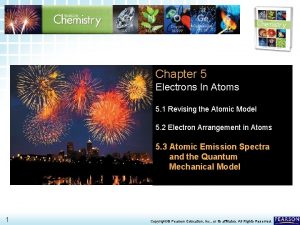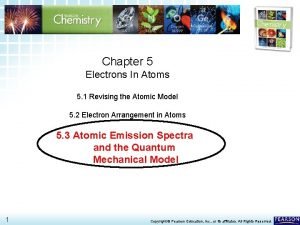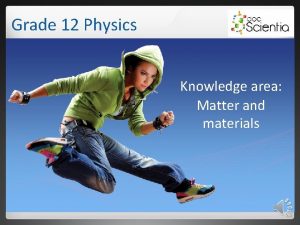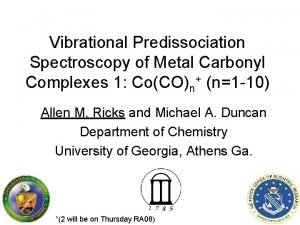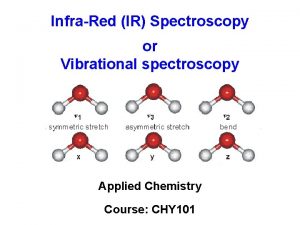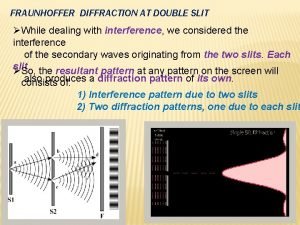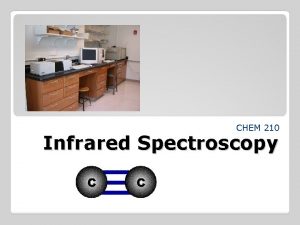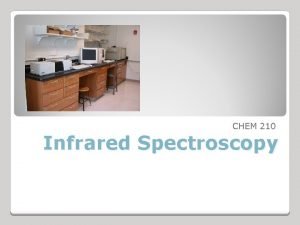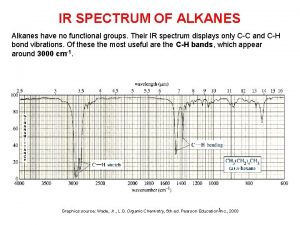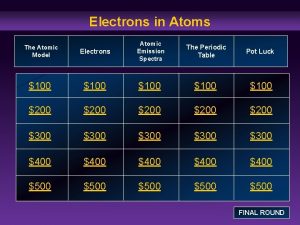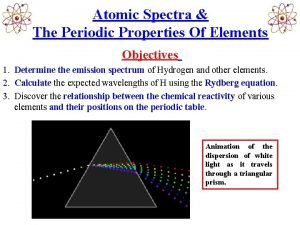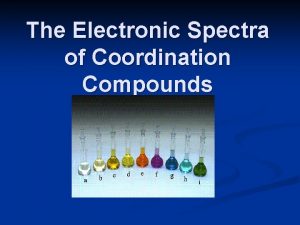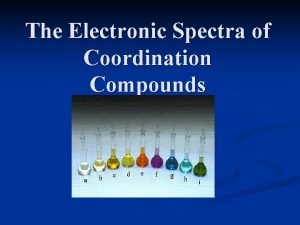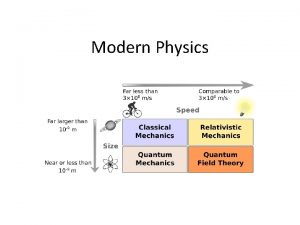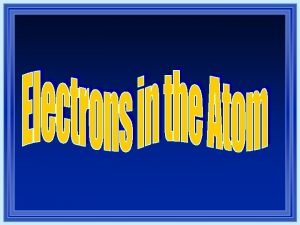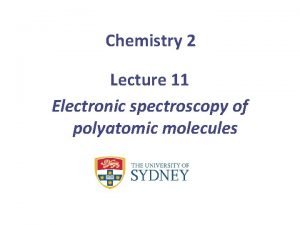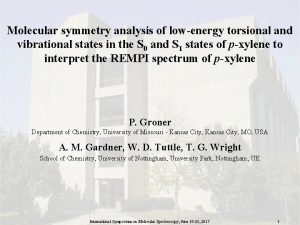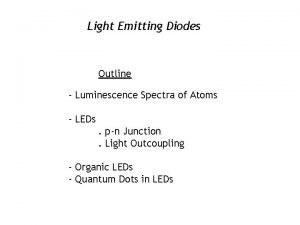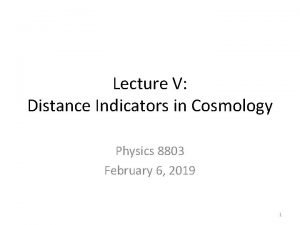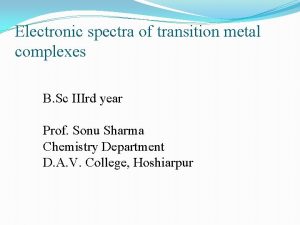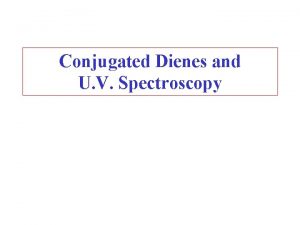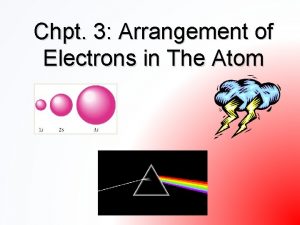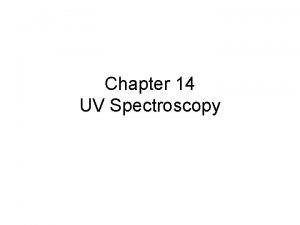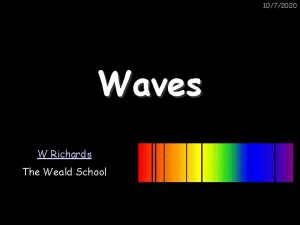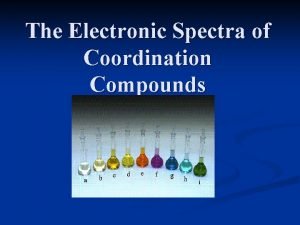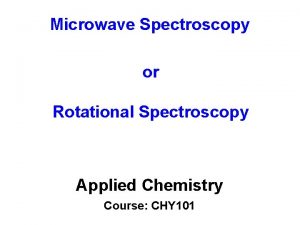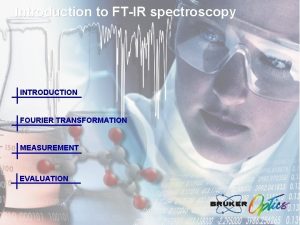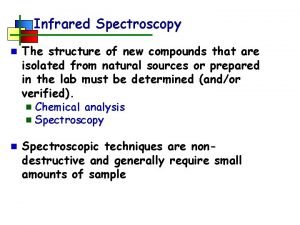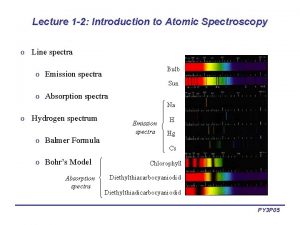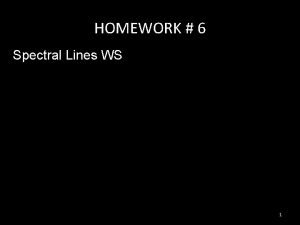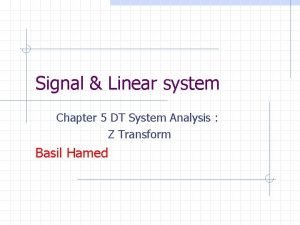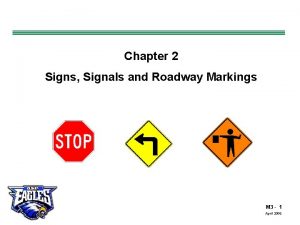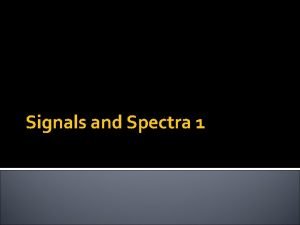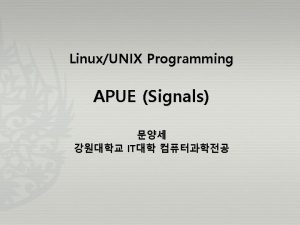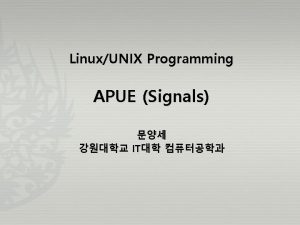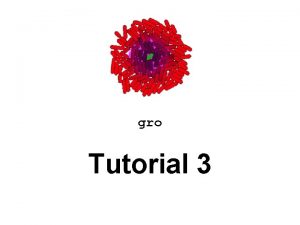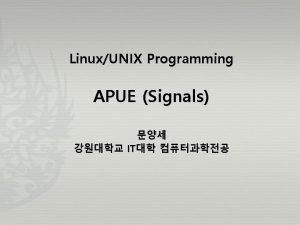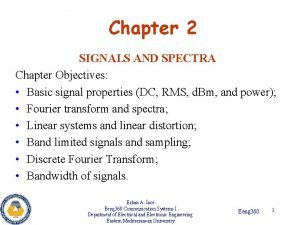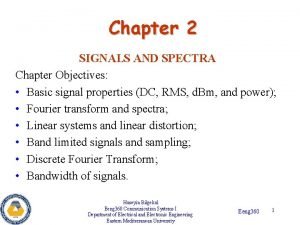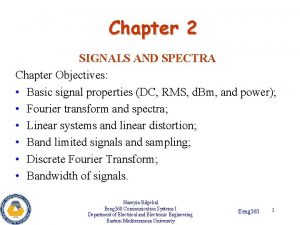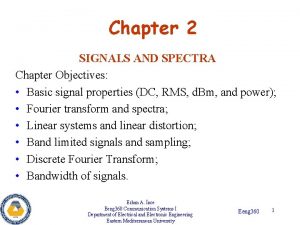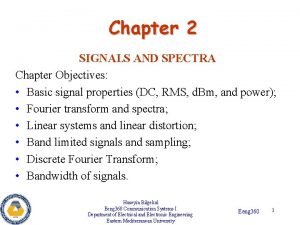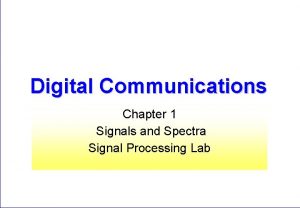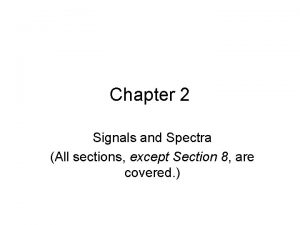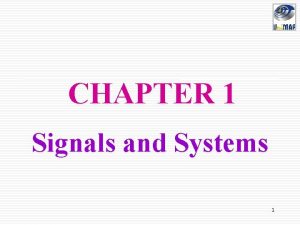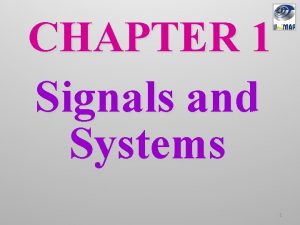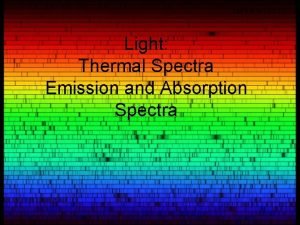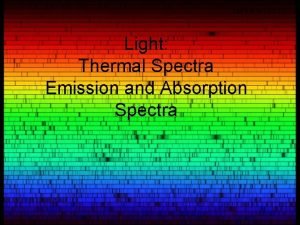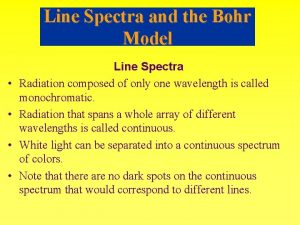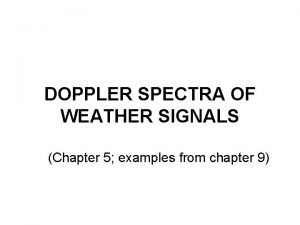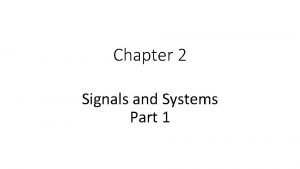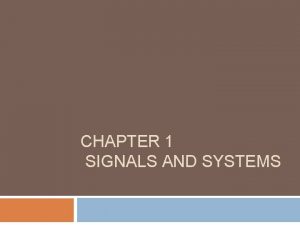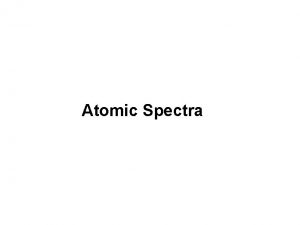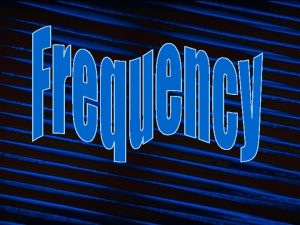q Chapter 2 Signals and Spectra This chapter










































- Slides: 42

q Chapter 2. Signals and Spectra Ø This chapter reviews one of the two pre-requisites for communications research. v. Signals and Systems v. Probability, Random Variables, and Random Processes Ø We use linear, particularly LTI, systems to develop theory for communications. Ø Outline v 2. 1 Line Spectra and Fourier Series v 2. 2 Fourier Transform and Continuous Spectra v 2. 3 Time and Frequency Relations v 2. 4 Convolution v 2. 5 Impulses and Transforms in the Limit v 2. 6 Discrete Time Signals and the Discrete Fourier Transform 1

o Communication Engineering 통신공학 Step 1. Given a communication medium, we first analyze the channel and build a mathematical model. 주어진 통신 매체에 따라 Channel 을 분석하고 모형을 만든다. Step 2. Using the model, we design the pair of a transmitter and a receiver that best exploits the channel characteristic. Channel 에 가장 효과적 신호처리를 할 수 있도록 Transmitter 와 Receiver를 설계한다. ex) Modulation (변조)과 Demodulation (복조) Encoding 과 Decoding Multiplexing 과 Demultiplexing 2

o Mathematical Tool for Signal Processing: Fourier Analysis time domain frequency domain analysis, synthesis, design q 2. 1 Line Spectra and Fourier Series o Linear Time-Invariant system 3



Line spectrum of periodic signals Amplitude A phase 복소지수 (Complex exponential)에 의한 sinusoidal wave정현파 신호 의 표현 복소수? Euler’s theorem/identity 6


Phasor를 이용한 정현파 신호의 표현 허수축 실수축 Phasor representation is useful when sinusoidal signal is processed by real-in real-out LTI systems. 8


A 1 Line Spectrum Phase Amplitude 90 5 3 0 10 40 2 0 35 10 35 Frequency content “왜 Phase는 Amplitude보다 덜 중요한가? (phase time delay ) “모든 주기적 신호는 정현파 신호의 선형적 결합으로 표현될 수 있다. ” 10

o Periodic Signals (주기 신호) Rectangular pulse train Figure 2. 1 -7 11

o Fourier Series 어떠한 periodic signal 정현파 신호의 선형적 집합 Where Phasor표현 two-sided line spectrum 12

주기함수의 주파수 특성 (Spectrum of periodic signals) 1. harmonics of fundamental frequency . 2. 3. 실함수 는 13

Spectrum of rectangular pulse train with ƒ 0 = 1/4 (a) Amplitude (b) Phase Figure 2. 1 -8 14

trigonometric Fourier series for real signals 매우 중요한 함수 15

Fourier-series reconstruction of a rectangular pulse train Figure 2. 1 -9 16

Fourier-series reconstruction of a rectangular pulse train Figure 2. 1 -9 c 17

Gibbs phenomenon at a step discontinuity Figure 2. 1 -10 18

Average Power of Periodic Signal 19

Ø Parseval’s Power Theorem 20

q 2. 2 Fourier Transforms and Continuous Spectra Ø Fourier Transform 비주기 신호 or Energy signal Definition called the analysis equation. 21

Ø Inverse Fourier Transform called the synthesis equation. 22

Ex 1 Rectangular pulse 23

Rectangular pulse spectrum V(ƒ) = A sinc ƒ Figure 2. 2 -2 24

Ø Rayleigh’s Energy Theorem Generally Also called Parseval’s relation/theorem. 25

Ø Duality Theorem 26

q 2. 3 Time and Frequency Relations Ø Superposition Property useful tool for linear systems Ø Time Delay linear phase Ø Time Scale Change Slow Playback Fast Playback Low Tone High Tone 27

Ø Frequency Translation/Shift and Modulation 28

continued (a) RF pulse (b) Amplitude spectrum Figure 2. 3 -3 29

Ø Differentiation and Integration Principle of FM demodulator differentiator In general Example. Triangular pulse 30

q 2. 4 Convolution Ø Convolution Integral Graphical interpretation of convolution Figure 2. 4 -1 31

Result of the convolution in Fig. 2. 4 -1 Figure 2. 4 -2 In general, convolution is a complicated operation in the TD. 32

Ø Convolution Theorems 33

q 2. 5 Impulses and Transforms in the Limit Ø Dirac delta function Thus 34

Two functions that become impulses as 0 Figure 2. 5 -2 35

Properties 36

Ø 실제적 함수 (Practical Impulses) 37

Ø Fourier Transform of Power Signals infinite energy 38

Ø From Fourier Series , Other periodic signals 39

q 2. 6 Discrete Time Signals and Discrete Fourier Transform Ø DT signal Ø DT periodic signal and DFTS v. Analysis equation v. Synthesis equation Ø DFT, IDFT v. Periodic extension and Fourier Series Ø DTFT v. Analysis equation v. Synthesis equation 40

Ø Convolution using the DFT v. Q. We are given a convolution sum of two finite-length DT signals. Each signal has support N_1, N_2. Find the finitelength (at most N_1+N_2 -1) output of the convolution using DFT. v. A. Choose N>= N_1+N_2 -1. Compute DFT(x) and DFT(h). Perform entry-by-entry multiplication. Apply the inverse DFT. Done. 41

q HW #1 (Due on Next Tuesday 9/22. Please turn in handwritten solutions. ) Ø 2. 7 Questions v 3 v 4 v 6 v 2. 1 -9, 13 v 2. 2 -7, 10 v 2. 3 -8, 14 v 2. 4 -8, 15 v 2. 5 -10 v 2. 6 -4, 6 42
 Animals and human language chapter 2
Animals and human language chapter 2 Communicative and informative signals
Communicative and informative signals Communicative and informative signals
Communicative and informative signals Atomic emission spectra and the quantum mechanical model
Atomic emission spectra and the quantum mechanical model Atomic emmision spectrum
Atomic emmision spectrum Emission and absorption spectra grade 12
Emission and absorption spectra grade 12 Iron carbonyl fe co 5 is
Iron carbonyl fe co 5 is Spectra tips
Spectra tips Spectra shropshire
Spectra shropshire Aromatic compound ir spectrum
Aromatic compound ir spectrum Fraunhoffer diffraction
Fraunhoffer diffraction Propionic anhydride ir spectrum
Propionic anhydride ir spectrum Spectroscopy formula
Spectroscopy formula Azza spectra
Azza spectra Terminal alkyne ir spectrum
Terminal alkyne ir spectrum Atomic emission spectra periodic table
Atomic emission spectra periodic table Periodic table of spectra
Periodic table of spectra Electronic spectra of coordination compounds
Electronic spectra of coordination compounds Electronic spectra of coordination compounds
Electronic spectra of coordination compounds Line spectra
Line spectra Why are atomic emission spectra discontinuous
Why are atomic emission spectra discontinuous What is nephelauxetic effect
What is nephelauxetic effect Electronic spectra of polyatomic molecules
Electronic spectra of polyatomic molecules Ir peak table
Ir peak table Vibronic spectra
Vibronic spectra Outline spectra
Outline spectra Supernova spectra
Supernova spectra Limitations of orgel energy level diagram
Limitations of orgel energy level diagram Uv spectra of dienes
Uv spectra of dienes Heisenberg uncertainty principle
Heisenberg uncertainty principle Uv spectra of dienes
Uv spectra of dienes Weald to waves
Weald to waves Correlation diagram in coordination chemistry
Correlation diagram in coordination chemistry Highest wavelength
Highest wavelength Microwave inactive molecules
Microwave inactive molecules Introduction of ftir
Introduction of ftir Ir spectroscopy table
Ir spectroscopy table Introduction to atomic spectra
Introduction to atomic spectra The diagram shows the characteristic spectral line
The diagram shows the characteristic spectral line Electro technic products inc
Electro technic products inc Mnova stacked spectra
Mnova stacked spectra Signals and systems oppenheim solutions chapter 5
Signals and systems oppenheim solutions chapter 5 Flourescent optic yellow signs
Flourescent optic yellow signs



